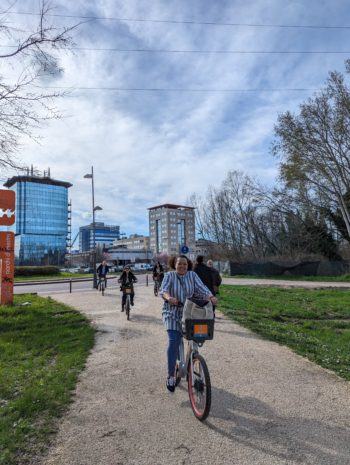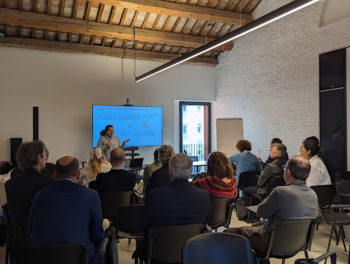Sustainable Cities Challenge: Our journey in Venice so far
17 July 2024
This blog has been co-written by Marie Plamondon and Hannah Ohlund
In this blog, we share our design journey with the City of Venice as part of Toyota Mobility Foundation’s Sustainable Cities Challenge.
Venice is a city that captures our imagination with its Venetian carnival, elegant Rialto Bridge and iconic gondolas gliding through narrow canals. The city has embraced multimodal transport options on both land and water to facilitate movement across its unique landscape.
In June, Challenge Works, in partnership with Toyota Mobility Foundation, World Resources Institute, and the City of Venice launched an open innovation challenge to seek novel ideas that encourage more people to use sustainable transport. Months of collaborative effort went into designing this challenge, ensuring it can make a significant local impact while also paving the way for scalable solutions in Venice and other cities worldwide facing similar challenges.

Discovering Venice
We began our collaboration with Venice in what we call our “discover and define” phase, during which we focused on understanding the city’s unique landscape to clarify what we were trying to achieve:
- What is the problem? Is it suitable for a challenge prize?
- What would help achieve the change we want? Is innovation necessary?
- Who are the key stakeholders?
- Who might enter the challenge and who might use the solution?
Throughout the design process, we’re constantly probing for answers and embracing the uncertainty of what lies ahead. We drew from our experiences with challenges like the Mayor’s Resilience Fund (2020) and the Climate Smart Cities Challenge (2022). Our discover and define phase produced three prototype designs — three different versions of a potential challenge to stimulate better uptake of sustainable transport modes in Venice.
Our design workshop in Venice marked a significant turning point. We experienced the city firsthand, exploring many of its sustainable transport options (bus, car, bike, train), moving between Mestre and Venice island. Mestre, a vibrant urban area serving as a vital transit hub linking the island to the mainland. A particular highlight was the guided bike ride led by Stefano Marchiante, an external communication expert dedicated to promoting bicycle use. Riding through Mestre, we experienced the cycling infrastructure, other mobility services available, and how people use these to support their daily movements across the city.
We learned that…
- 20% of trips in Venice are less than 3 km, suggesting that bicycles could be a viable option if barriers are addressed.
- Bicycles are perceived as less convenient for multi-purpose trips, such as dropping kids off at school or grocery shopping.
- Safety perceptions and infrastructure, especially in city centers, influence bicycle usage.
- Personal convenience and lifestyle choices, such as preferring homes outside the city center, make car usage more appealing than bicycles.
- In the Venice region, most households own 2 to 3 private vehicles.
It was clear that Venice has invested in many eco-friendly ways to get around, like bikes, scooters, water taxis, buses, and trains. Despite this, not enough people are using these green mobility options. This is why the city is seeking new ideas that encourage people to choose sustainable transport, focusing on what motivates people and their choices, rather than building more infrastructure or introducing policy changes.
Leveraging the World Resources Institute’s research, during the workshop, we reviewed Venice’s mobility landscape, highlighting the role of Azienda Veneziana della Mobilità (AVM SpA), which manages public transport across Venice and its suburbs, and discussing the integration of electronic ticketing through the Venezia Unica card. Throughout the session, we explored innovative initiatives like the MO-VE-Nice shared mobility program, RideMovi‘s bike-sharing service with 1,000 bicycles (500 electric and 500 manual), BIT Mobility‘s electric scooter rentals, and the Kinto car-sharing service. We learned about the comprehensive transport network’s connectivity from the mainland to the city center, while also identifying areas that may be underserved and the need for ongoing improvements to enhance sustainability and reduce traffic congestion.

The workshop gave us the opportunity to see whether our three proposed challenge designs resonated with local stakeholders, as well as the chance to gather essential feedback to refine our design. The City of Venice played a crucial role in convening a diverse set of stakeholders, including transport providers and researchers (e.g., Ca’ Foscari University of Venice), whose insights were invaluable in understanding the city’s mobility challenges and needs.
What we’ve learned with the stakeholders and the City of Venice
- Scooter use is particularly high in Venice, the fourth most active city for scooters managed by Bit Mobility. In 2023, there were 368,000 scooter rentals by approximately 16,000 users, covering 3.75 million km. Men comprise 73% of users, with an average trip distance of 2km.
- Scooter sharing is predominantly driven by younger users, with 45% of users aged 18-25 and another 40% aged 25-45.
- Converting 50% of trips under 2 km to bicycles could reduce traffic jams significantly.
- According to a survey by Center for Automotive e Mobility Innovation (CAMI) at Ca’ Foscari’s Department of Management, 61.7% of respondents under 30-years-old would give up their cars if public transport were efficient.
Engaging with these stakeholders allowed us to delve deeper and ask critical questions such as:
- Who would be the target audience for the challenge?
- What could trigger people to change their mobility habits?
- What types of innovators might be interested in a challenge focused on embracing sustainable mobility?
- What kinds of data would innovators require to participate effectively?
The team that participated in the design workshops at the Ca’ Farsetti Palace, a government office, included members from the Toyota Mobility Foundation, Challenge Works, the World Resources Institute, and the City of Venice.
Our time in Venice enabled us to understand the mobility challenges so much more clearly and deeply than virtual interactions could convey. This helped us refine the challenge statement that would eventually lead to the Sustainable Cities Challenge in Venice. Our collaboration with Venice, stakeholders, and our delivery partners has not only shaped an ambitious challenge for the city but also laid the groundwork for solutions to create a local step-change and inspire cities across the globe dealing with comparable mobility challenges.

What’s next?
We are looking for innovators with bold ideas that can encourage the use of sustainable transport modes in Venice, with a focus on the mainland and motorized islands. Solutions must address at least one of the following:
- Increasing active mobility
- Increasing public transport use
- Increasing usage of shared mobility
The Sustainable Cities Challenge Venice is now closed for entries.


